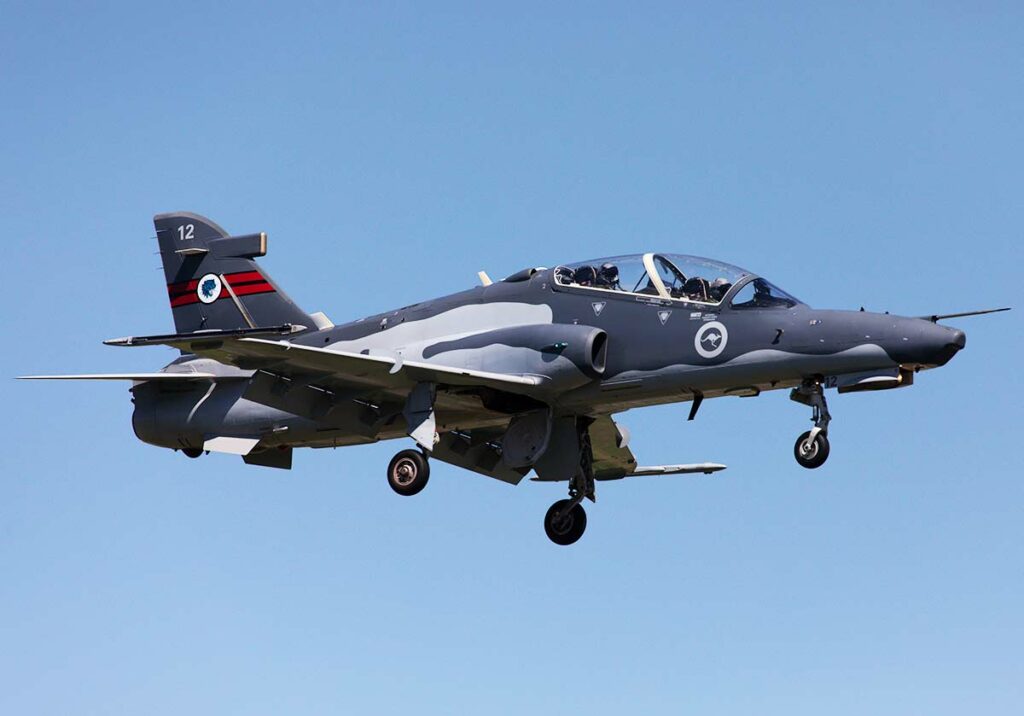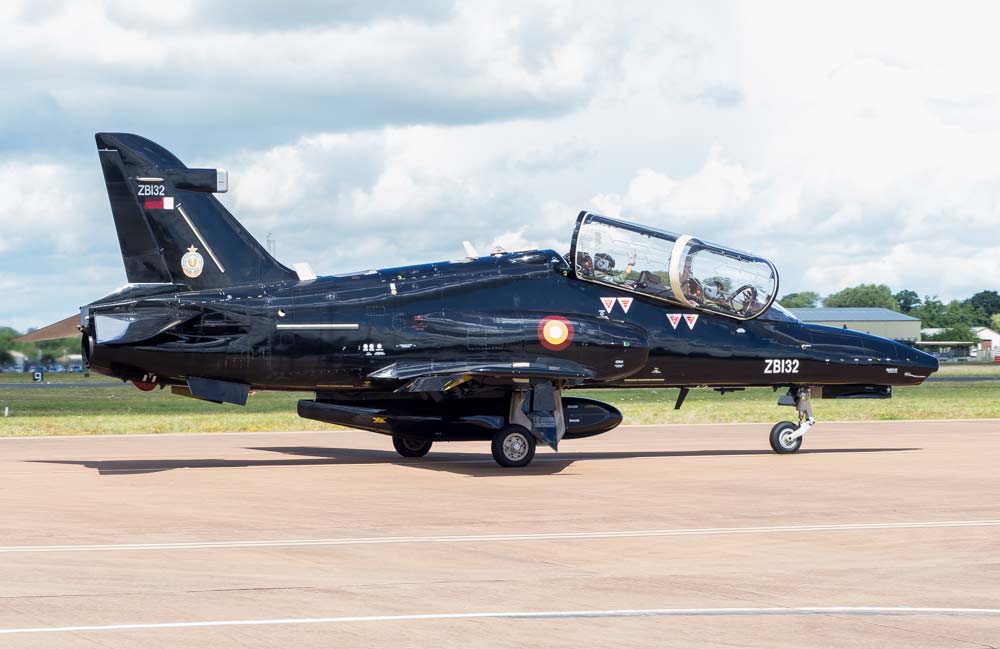BAe Hawk: Advanced jet trainer and light combat aircraft.
In brief
The BAe Hawk is a British single-engine, jet-powered advanced trainer aircraft used by numerous air forces globally. Since its inception by British Aerospace (now BAE Systems), it has been renowned for its agility, reliability, and cost-effectiveness. The Hawk features a low-wing design, with a Rolls-Royce Turbomeca Adour engine capable of speeds up to 645 mph (1,038 km/h). With a maximum takeoff weight of 9,100 kg and a range of 1,500 miles (2,414 km), the Hawk serves both training and light combat roles, boasting modifications for ground attack and aerial defense capabilities.

History of the Development of the BAe Hawk
The BAe Hawk traces its roots back to the 1960s when the Royal Air Force (RAF) identified the need for a new jet training aircraft to replace the aging Gnat and Hunter trainers. British Aerospace (BAe), then known as Hawker Siddeley, commenced development of the Hawk in the early 1970s under the project name HS.1182. This project aimed to create an aircraft that was not only effective in training pilots in jet operations but also versatile enough to undertake light attack duties.
The program officially began in 1972, and the Hawk made its maiden flight on August 21, 1974. The design and development phase focused on creating an aircraft that was economical to produce and operate, with robustness and simplicity being key elements to ensure low maintenance costs and high reliability—attributes critical for a training aircraft.
The BAe Hawk was designed without a NATO reporting name, as it was primarily an export product and a training aircraft, unlike frontline combat aircraft that typically receive such designations. The introduction of the Hawk was timely, as military aviation technology was rapidly advancing, requiring new pilots to train on aircraft that closely mimicked the handling and performance characteristics of frontline fighters.
By integrating features such as a high-service ceiling, good endurance, and the capability to carry a variety of weapons, the Hawk was not just a trainer but also a capable light combat aircraft. This dual-role capability ensured its appeal to a broader market, facilitating significant export success. The Hawk officially entered service with the RAF in 1976, marking the beginning of a long and successful operational tenure.
Design of the BAe Hawk
The BAe Hawk features a traditional aerodynamic formula with a low-mounted wing and a single central engine, providing a good balance between aerodynamic efficiency and maintenance accessibility. The aircraft’s airframe is constructed primarily from aluminum alloys, which contribute to a light yet sturdy structure. Its tricycle undercarriage is retractable, designed to support the rigors of frequent takeoffs and landings during training operations.
In terms of dimensions, the Hawk measures approximately 39 feet (11.9 meters) in length with a wingspan of 31 feet (9.4 meters). The powerplant, a Rolls-Royce Turbomeca Adour turbofan engine, produces around 5,200 pounds of thrust, allowing for a top speed of approximately 645 mph (1,038 km/h) at altitude. The Hawk’s operational range is about 1,500 miles (2,414 km) with internal fuel, and it can reach a service ceiling of up to 44,500 feet (13,564 meters).
One of the design highlights of the Hawk is its cockpit, which is equipped with tandem seats and advanced avionics that mirror the configurations found in frontline fighter jets. This setup prepares trainees for transition to more complex aircraft. The aircraft can also be fitted with a variety of weapons, including cannons, rockets, and missiles, making it adaptable for combat roles.
While the Hawk is celebrated for its reliability and ease of maintenance, its simplicity also brings limitations. The aircraft lacks the sophisticated radar and sensor systems found in more modern trainers and combat aircraft, which can restrict its operational role in advanced air force training and combat scenarios.
Performance of the BAe Hawk
The performance of the BAe Hawk is robust, given its role as a trainer and secondary combat aircraft. Its Rolls-Royce Turbomeca Adour engine provides a solid thrust-to-weight ratio, facilitating a maximum speed of 645 mph (1,038 km/h). This capability allows it to simulate high-speed jet operations for trainee pilots effectively.
In comparison to competitors like the Alenia Aermacchi M-346 Master and the Northrop T-38 Talon, the Hawk holds its ground by offering a good mix of speed, agility, and low operational costs. The Hawk’s range of approximately 1,500 miles (2,414 km) and its service ceiling of 44,500 feet (13,564 meters) make it a versatile asset for both training and light attack missions.
Variants of the BAe Hawk
The Hawk has evolved through multiple variants, each tailored to meet specific training or combat needs. The T1 variant was the initial model used by the RAF for fast-jet pilot training. The T2, a more advanced version, features upgraded avionics and digital glass cockpits similar to those in modern fighter aircraft.
For export, BAe developed several variants, including the Hawk 50, which had limited combat capabilities, and the Hawk 100 series, which featured modernized avionics and provisions for advanced weaponry. The Hawk 200 is a single-seat variant, optimized for combat with enhanced avionic systems and an increased weapons payload capacity.

Military Use and Combat of the BAe Hawk
The Hawk has seen extensive military use, primarily as a trainer but also in combat roles. It has been employed by air forces around the world, including those of the UK, Canada, Australia, and India. The Hawk’s adaptability as a combat aircraft was demonstrated during the Falklands War, where it was used for air defense operations by the British forces.
In more recent years, variants of the Hawk equipped with advanced targeting systems have been used in light attack roles, supporting ground operations with precision strikes. The aircraft’s capability to carry a range of munitions makes it a valuable asset in low-intensity conflicts where high-performance fighter jets would be less cost-effective.
The Hawk continues to be in service across various air forces, with ongoing upgrades to avionics and systems ensuring its relevance in modern training curricula. It has been replaced in some roles by newer aircraft like the T-6 Texan II and the M-346 Master, but its legacy as a reliable and versatile trainer and light combat aircraft is secured.
The BAe Hawk remains a cornerstone in military aviation training and light combat operations. Its design efficiency, operational flexibility, and cost-effectiveness have established it as one of the most successful jet trainers in aviation history. As it continues to serve and adapt, the Hawk exemplifies the enduring value of a well-designed aircraft that meets the diverse needs of modern air forces.
Back to the Fighter Jet section.